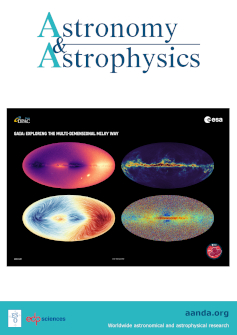The rich galactic environment of a H2-absorption-selected quasar
IF 5.4
2区 物理与天体物理
Q1 ASTRONOMY & ASTROPHYSICS
引用次数: 0
Abstract
We present the first Very Large Telescope (VLT) Multi Unit Spectroscopic Explorer (MUSE) observations of a quasar featuring a proximate molecular absorption system, SDSS J125917.31+030922.5. The proximate damped Lyα absorption acts as a natural coronagraph, removing the quasar emission over ∼40 Å in wavelength, and allows us to detect extended Lyα emission without the necessity of subtracting the quasar emission. This natural coronagraph permits the investigation of the quasar environment down to its inner regions (r < 20 kpc), where galaxy interactions or feedback processes should have the most noticeable effects. Our observations reveal a dense environment, with a highly asymmetric Lyα emission within 2″ (∼15 kpc), possibly shaped by a companion galaxy, and a southern extension of the nebulae to about 50 kpc, with rotation-like kinematic signature. The width of the Lyα emission is broadest closer to the quasar, indicating perturbed kinematics as expected if interactions and significant gas flows are present. The foreground absorbing system itself is redshifted by ≈400 km/s relative to the background quasar, and therefore is likely arising from gas moving toward the quasar. Finally two additional Lyα emitters are detected with > 10σ significance at 96 and 223 kpc from the quasar, making this field overdense relative to other similar observations of quasars at z ∼ 3. Our results support the hypothesis that quasars with proximate neutral and molecular absorption trace rich environments where galaxy interactions are at play and motivates further studies of H2-selected quasars to shed light on feeding and feedback processes.一个H2-吸收选择类星体的丰富星系环境
我们首次展示了超大望远镜(VLT)多单元光谱探测器(MUSE)对具有近似分子吸收系统的类星体--SDSS J125917.31+030922.5--的观测结果。近似的阻尼 Lyα 吸收起到了天然日冕仪的作用,可以去除波长超过 40 Å 的类星体发射,使我们无需减去类星体发射就能探测到延伸的 Lyα 发射。这种天然的日冕仪可以探测到类星体的内部环境(2″(∼15 kpc)范围内的r α发射,可能是由一个伴星系形成的,星云向南延伸到大约50 kpc,具有类似自转的运动学特征)。Lyα发射的宽度在靠近类星体的地方最宽,这表明如果存在相互作用和大量气体流,就会出现扰动运动学。前景吸收系统本身相对于背景类星体红移了≈400 km/s,因此很可能是由向类星体移动的气体产生的。最后,在距离类星体 96 kpc 和 223 kpc 的地方还探测到了两个意义大于 10σ 的 Lyα 发射器,这使得这个场相对于 z ∼ 3 的其他类似类星体观测结果来说过于密集。我们的结果支持了这样的假设,即类星体具有近似的中性和分子吸收,可以追踪到星系相互作用的丰富环境,并促使我们进一步研究H2选择的类星体,以揭示馈源和反馈过程。
本文章由计算机程序翻译,如有差异,请以英文原文为准。
求助全文
约1分钟内获得全文
求助全文
来源期刊

Astronomy & Astrophysics
地学天文-天文与天体物理
CiteScore
10.20
自引率
27.70%
发文量
2105
审稿时长
1-2 weeks
期刊介绍:
Astronomy & Astrophysics is an international Journal that publishes papers on all aspects of astronomy and astrophysics (theoretical, observational, and instrumental) independently of the techniques used to obtain the results.
文献相关原料
| 公司名称 | 产品信息 | 采购帮参考价格 |
|---|
 求助内容:
求助内容: 应助结果提醒方式:
应助结果提醒方式:


